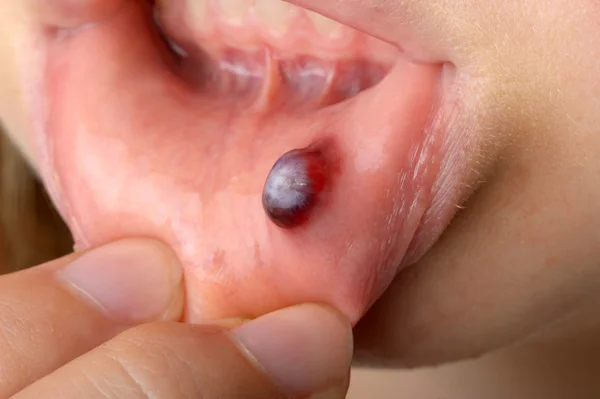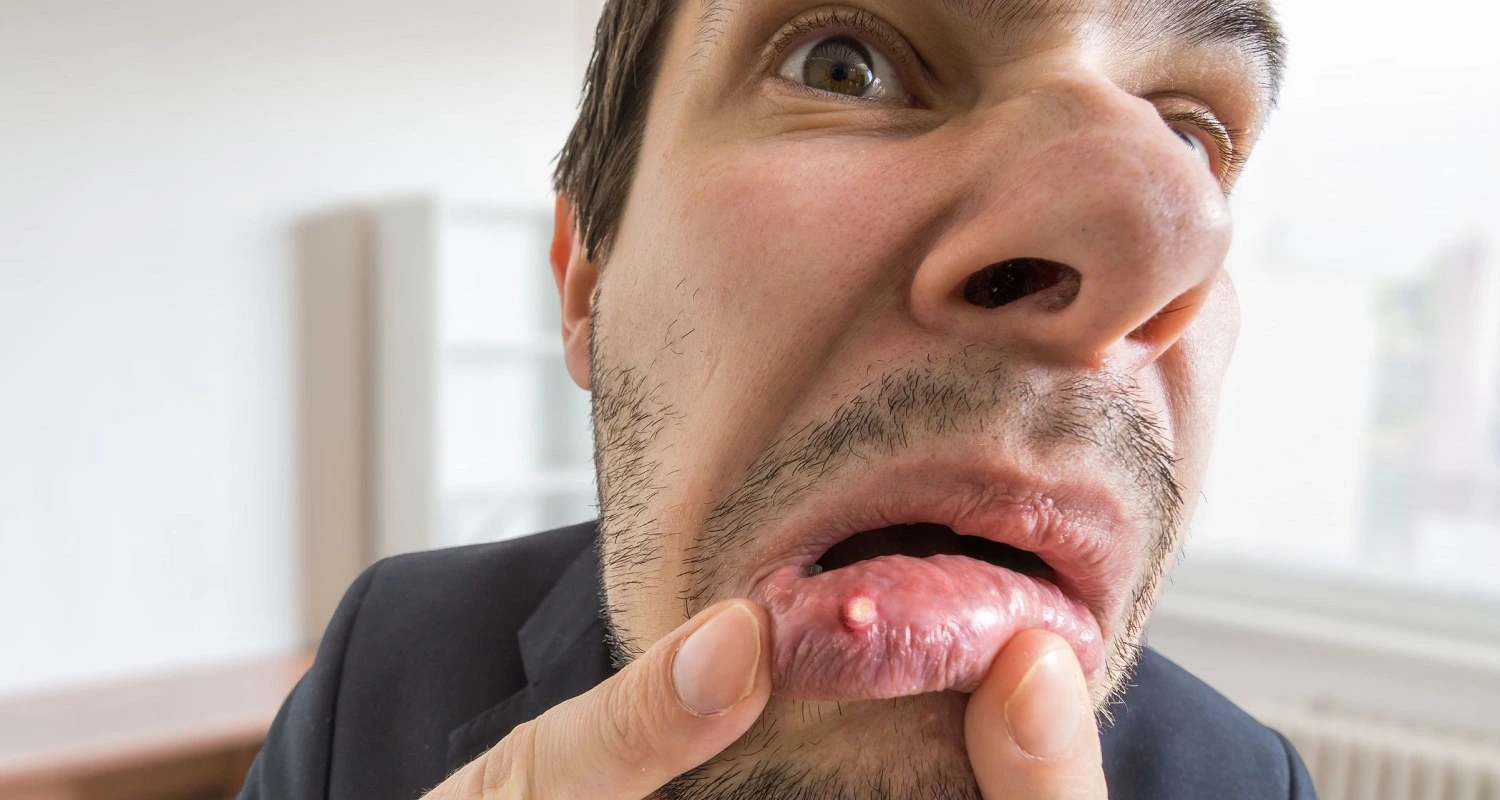Last Updated on: 19th September 2025, 12:52 pm
Blood blisters in the mouth are a relatively common condition that can be an uncomfortable and unpleasant experience, as well as a cause for concern and alarm for many patients.
Some doubts about the formation and management of these lesions are clarified below.
What is a Blood Blister in the Mouth?
Blisters are sacs filled with blood or other liquids that form in some areas of the mouth such as the palate, tongue, or inside of the cheek.
When they are blood blisters, a clot forms inside them, giving them a dark red or purple appearance.
Blood Blisters in the Mouth vs. Other Sores in the Mouth
Many types of lesions can appear in the mouth, so it is normal to confuse them with each other. It is important to differentiate blood blisters from vesicles or other lesions caused by general, infectious, or blood diseases. Blood blisters are often distinguished by:
• Place of appearance: They usually form in areas exposed to trauma (bites, areas where dentures are fitted, and places where anesthesia has been applied, among others). The most frequent site of formation is the posterior part of the palate.
• Formation time: It forms quickly and lasts a few minutes or hours before bursting, that is, before all the liquid inside comes out.
• Healing time: Once the blister has broken, there is usually a wound (called an ulcer) that will take between 3 and 10 days to heal.
• Quantity: They usually appear isolated, that is, they are usually unique.
• Size: They reach an average size between 1 and 3 cm in diameter.
For further information, you can check out the related article that covers various aspects of this common oral health concern about mouth and canker sore.
What is Angina Bullosa Hemorrhagic (ABH)?
Angina bullosa hemorrhagic (ABH) is a disease in which blood-filled blisters form in the mouth. Sometimes they go away and come back over time while sometimes they can come back several times within a few months.
The blisters are usually rapid and sudden onset. They mostly affect people between the fifth and seventh decade of life, regardless of gender. Although attempts have been made to link it to coagulation, metabolic, and renal disorders, it appears that this is only speculation. Usually, these blisters are not attributed to any general disease.
What are the Causes of Angina Bullosa Hemorrhagic (ABH)?
The most obvious cause of hemorrhagic bullous angina is trauma. When the mucosa is injured, these blisters are more likely to form. In the mouth, trauma can be generated by various situations:
1. Consumption of very hard, crunchy, or hot foods.
2. Bites on the inside of the cheek or the tongue.
3. Medical procedures that hurt the mouth, such as an endoscopy.
4. Ill-fitting dentures.
5. Orthodontic appliances that lacerate the mucosa.
6. Allergic reactions.
7. Dental restorations (healings or shims) poorly adapted or with sharp edges.
8. Dental procedures, such as the application of anesthesia or cleanings.
It is believed that other factors such as the use of medications including inhaled corticosteroids (inhalers to treat respiratory conditions) can weaken the oral mucosa and facilitate blistering and bleeding when trauma occurs. In many cases, it is not possible to find an obvious cause of angina bullosa hemorrhagic.
What does it Feel Like When a Blood Blister Comes out in the Mouth?
In most cases, blood blisters appear in the mouth and do not generate any more symptoms than a bulge in the area. But some people may feel pain that may be light or stabbing, or a burning sensation just before the blister forms. These usually last only a few minutes or hours before rupturing, leaving a shallow sore that will take 3 to 10 days to heal.
Oral Blood Blister Treatment
Blood blisters usually heal quickly and do not require treatment. If the sores that remain after the blister has burst are painful or uncomfortable, these tips may help to ease the discomfort:
1. Ice
Placing ice on the ulcer for 10 minutes several times a day helps reduce inflammation and can provide a feeling of relief.
Rinses with calendula or chamomile can help reduce inflammation.
2. Sliced cucumber
Cucumber has properties that promote healing; placing a slice of cucumber on the ulcer several times a day for a few minutes can help it heal faster.
3. Food care
Avoid crunchy, acidic, very salty, or difficult-to-chew foods that could hurt the area again.
4. Turmeric balm
Turmeric is a spice that has proven to be fabulous in helping reduce inflammation and pain. It can be mixed with honey to form a thick paste and applied with a cotton swab to the ulcer every night.
5. Rinsing with chlorhexidine helps keep the area clean and prevent infection
These should not be carried out for more than 5 days since they could generate changes in the perception of the taste of food or produce stains on the teeth.
When to See a Dentist?
Although in most cases the blisters break and the mucosa heals after a few days, at times it will be necessary to visit a dentist:
• Large size: If the blister is so large that it interferes with swallowing or breathing, the dentist may need to help release the contents of the blister to reduce its size and relieve the sensation of choking.
• It does not heal quickly: If after two weeks it has not healed, the dentist should do an examination and verify that it is only a blister and not a lesion that implies an important disease.
• Infected blister: If you notice redness around the blister, drainage of pus and warmth in the area is indicated.
• Very severe pain: If the pain prevents eating and performing daily activities, you may be prescribed painkillers or medications to speed healing.
• Recurring blisters: When the blisters disappear and reappear frequently, it is prudent to perform medical tests to rule out the existence of a medical disorder.
• Blisters generated by prostheses or appliances: The dentist will make adjustments to the dentures and orthodontic appliances to prevent these implements from hurting the mouth, thus helping the blister to heal and preventing its reappearance.
Recommendations
This condition can be very uncomfortable for some people and sometimes it will affect their peace of mind and image. To help improve or prevent blood blisters, it is suggested to avoid spicy foods, and not use dentures until the blood blister disappears or bursts the blister.
Preferably eat white foods while the blister disappears, and in frequent cases visit the dentist or doctor.
Frequently Asked Questions
What Leads to Blood Blisters in the Mouth?
Blood blisters in the mouth are typically caused by accidental injury. Many can be treated at home using remedies like ice, turmeric, and witch hazel. However, if the blisters are large or keep coming back, it may be necessary to seek medical care. Sometimes, these blisters can arise from other causes, particularly if they occur frequently or fail to heal properly.
What Are the Characteristics of a Cancerous Blood Blister?
A cancerous blood blister appears as a firm, dome-shaped growth on the skin. It may show varied discoloration, including shades of red, pink, brown, black, blue-black, or may match your skin tone. The texture of these blisters can be smooth, crusty, or rough, resembling cauliflower. They may also bleed.
What Vitamin Deficiency Leads to Blood Blisters in the Mouth?
Blood blisters in the mouth can sometimes be linked to nutritional deficiencies. These deficiencies often include a lack of iron, vitamin B3 (associated with pellagra), vitamin C (related to scurvy), folic acid, or vitamin B12. Recurrent aphthous stomatitis, a condition marked by the appearance of these blisters, is frequently connected to these specific nutrient shortages.
What Does an Oral Blood Blister Look Like?
Oral blood blisters are raised lesions that typically appear red. They can also be oval-shaped and vary in color from white to cream, depending largely on the type of fluid contained within the blister.
How to Treat a Blister in the Mouth?
To alleviate a blister in the mouth, start by applying an antiseptic gel directly to the ulcer. Additionally, rinse your mouth with warm, mildly salted water, holding the rinse in your mouth for about four minutes per session. Do this four times a day. It’s also beneficial to use an alcohol-free medicated mouthwash, ideally one containing chlorhexidine gluconate, twice daily.
Share:
References
1. Marcin, A. (2018, September 18). What’s Causing My Sore Tongue? Healthline. https://www.healthline.com/health/dental-and-oral-health/sore-tongue
2. Fletcher, J. (2022b, January 28). Blood blister in mouth: Pictures and treatment. https://www.medicalnewstoday.com/articles/320115
3. Silva-Cunha, JL, Cavalcante, IL, Barros, CC, Felix, FA, Venturi, LB, Rolim, LS, Silva-Júnior, CL, Sousa, EM, da Silveira, É. J., Agostini, M., Romañach, -J., & Almeida, OP (2022). Bullous hemorrhagic angina: A 14-year multi-institutional retrospective study from Brazil and review of the literature. Oral Medicine, Oral Pathology and Oral Surgery, 27(1), E35–E41. https://doi.org/10.4317/medoral.24870
4. Angina Bullosa Hemorrhagica: Post-traumatic Swelling in the Oral Cavity—A Case Report – Jeroen PM Peters, Pauline MW van Kempen, Sybren MM Robijn, Hans GXM Thomeer , 2020 (sagepub.com) https://journals.sagepub.com/doi/epdf/10.1177/2320206820913696
-
Nayibe Cubillos M. [Author]
Pharmaceutical Chemestry |Pharmaceutical Process Management | Pharmaceutical Care | Pharmaceutical Services Audit | Pharmaceutical Services Process Consulting | Content Project Manager | SEO Knowledge | Content Writer | Leadership | Scrum Master
View all posts
A healthcare writer with a solid background in pharmaceutical chemistry and a thorough understanding of Colombian regulatory processes and comprehensive sector management, she has significant experience coordinating and leading multidisciplina...




















